LPE Growth of Single Crystalline Film Scintillators Based on Ce3+ Doped Tb3−xGdxAl5−yGayO12 Mixed Garnets
Abstract
:1. Introduction
2. Growth of Tb3−xGdxAl5−yGayO12:Ce Single Crystalline Films
3. Luminescent and Scintillation Properties of Tb3−xGdxAl5−yGayO12:Ce Single Crystalline Films
3.1. Cathodoluminescence Spectra
3.2. Scintillation Decay Kinetics
3.3. TSL Properties
3.4. Photoelectron Light Yield Measurements
4. Conclusions
Acknowledgments
Author Contributions
Conflicts of Interest
References
- Koch, A.; Raven, C.; Spanne, P.; Snigirev, A. X-ray imaging with submicrometer resolution employing transparent luminescent screens. J. Opt. Soc. Am. A 1998, 15, 1940–1951. [Google Scholar] [CrossRef]
- Koch, A.; Peyrin, F.; Heurtier, P.; Ferrand, B.; Chambaz, B.; Ludwig, W.; Couchaud, M. X-ray camera for computed microtomography of biological samples with micrometer resolution using Lu3Al5O12 and Y3Al5O12 scintillators. Proc. SPIE 1999, 3659, 170–179. [Google Scholar]
- Martin, T.; Koch, A. Recent developments in X-ray imaging with micrometer spatial resolution. J. Synchrotron Radiat. 2006, 13, 180–194. [Google Scholar] [CrossRef] [PubMed]
- Zorenko, Y.; Gorbenko, V.; Voznyak, T.; Martin, T.; Douissard, P.-A.; Mares, J.A.; Nikl, M. LuAG:Pr, LuAG:La, and LuAP:Ce thin film scintillators for visualisation of X-ray images. Int. Soc. Opt. Photonics 2009, 7310, 731007. [Google Scholar]
- Martin, T.; Douissard, P.-A.; Couchaud, M.; Cecilia, A.; Baumbach, T.; Dupré, K.; Rack, A. LSO-based single crystal film scintillator for synchrotron-based hard X-ray micro-imaging. IEEE Trans. Nucl. Sci. 2009, 56, 1412–1418. [Google Scholar] [CrossRef]
- Douissard, P.-A.; Cecilia, A.; Rochet, X.; Chapel, X.; Martin, T.; Van De Kamp, T.; Helfen, L.; Baumbach, T.; Luquot, L.; Xiao, X.; et al. A versatile indirect detector design for hard X-ray microimaging. J. Instrum. 2012, 7, P09016. [Google Scholar] [CrossRef]
- Douissard, P.-A.; Cecilia, A.; Martin, T.; Chevalier, V.; Couchaud, M.; Baumbach, T.; Dupré, K.; Kühbacher, M.; Rack, A. A novel epitaxially grown LSO-based thin-film scintillator for micro-imaging using hard synchrotron radiation. J. Synchrotron Radiat. 2010, 17, 571–583. [Google Scholar] [CrossRef] [PubMed]
- Cecilia, A.; Rack, A.; Douissard, P.-A.; Martin, T.; dos Santos Rolo, T.; Vagovič, P.; Hamann, E.; van de Kamp, T.; Riedel, A.; Fiederle, M.; et al. LPE grown LSO:Tb scintillator films for high-resolution X-ray imaging applications at synchrotron light sources. Nucl. Instrum. Meth. A 2011, 648, S321–S323. [Google Scholar] [CrossRef]
- Zorenko, Y.; Nikl, M.; Gorbenko, V.; Savchyn, V.; Voznyak, T.; Kucerkova, R.; Sidletskiy, O.; Grynyov, B.; Fedorov, A. Growth and luminescent properties of Lu2SiO5 and Lu2SiO5:Ce single crystalline films. Opt. Mater. 2011, 33, 846–852. [Google Scholar] [CrossRef]
- Zorenko, Y.; Gorbenko, V.; Savchyn, V.; Voznyak, T.; Grinyov, B.; Sidletskiy, O.; Kurtsev, D.; Fedorov, A.; Baumer, V.; Nikl, M.; et al. Growth and luminescent properties of Lu2SiO5:Ce and (Lu1−xGdx)2SiO5:Ce single crystalline films. J. Cryst. Growth 2011, 337, 72–80. [Google Scholar] [CrossRef]
- Zorenko, Y.; Gorbenko, V.; Savchyn, V.; Voznyak, T.; Gorbenko, V.V.; Nikl, M.; Mares, J.A.; Sidletskiy, O.; Grynyov, B.; Fedorov, A.; et al. Scintillation and luminescent properties of undoped and Ce3+ doped Y2SiO5 and Lu2SiO5 single crystalline films grown by LPE method. Opt. Mater. 2012, 34, 1969–1974. [Google Scholar] [CrossRef]
- Zorenko, Y.; Gorbenko, V.; Savchyn, V.; Zorenko, T.; Grinyov, B.; Sidletskiy, O.; Fedorov, A.; Mares, J.A.; Nikl, M.; Kucera, M. Lu2SiO5:Ce and Y2SiO5:Ce single crystals and single crystalline film scintillators: Comparison of the luminescent and scintillation properties. Radiat. Meas. 2013, 56, 84–89. [Google Scholar] [CrossRef]
- Twardak, A.; Bilski, B.; Zorenko, Y.; Zorenko, T.; Gorbenko, V.; Mandowska, E.; Mandowski, A.; Sidletskiy, O.; Mares, J. Thermoluminescent properties of undoped and Ce-Doped lutetium orthosilicate and yttrium orthosilicate single crystals and single crystalline films scintillators. IEEE Trans. Nucl. Sci. 2014, 61, 276–281. [Google Scholar] [CrossRef]
- Zorenko, Y.; Gorbenko, V.; Savchyn, V.; Zorenko, T.; Grinyov, B.; Sidletskiy, O.; Fedorov, A. Growth and luminescent properties of Ce and Ce-Tb doped (Y, Lu, Gd)2SiO5:Ce single crystalline films. J. Cryst. Growth 2014, 401, 577–583. [Google Scholar] [CrossRef]
- Riva, F. Towards a New Generation of Thin Scintillating Films to Fit the Synchrotron Needs. Available online: http://www.success.kharkov.ua/news/4ws/riva.pdf (accessed on 27 August 2017).
- Zorenko, Y.; Gorbenko, V.; Nikl, M.; Mares, J.A.; Martin, T.; Douissard, P.-A. Development of novel UV emitting single crystalline film scintillators. IEEE Trans. Nucl. Sci. 2010, 57, 1335–1342. [Google Scholar] [CrossRef]
- Zorenko, Y.; Gorbenko, V.; Savchyn, V.; Voznyak, T.; Sidletskiy, O.; Grinyov, B.; Nikl, M.; Mares, J.A.; Martin, T.; Douissard, P.-A. Single crystalline film scintillators based on the orthosilicate, perovskite and garnet compounds. IEEE Trans. Nucl. Sci. 2012, 59, 2260–2268. [Google Scholar] [CrossRef]
- Douissard, P.-A.; Martin, T.; Riva, F.; Mathieu, E.; Zorenko, Y.; Savchyn, V.; Zorenko, T.; Fedorov, A. Scintillating screens for micro-imaging based on the Ce-Tb doped LuAP single crystal films. IEEE Trans. Nucl. Sci. 2014, 61, 433–438. [Google Scholar] [CrossRef]
- Riva, F.; Douissard, P.-A.; Martin, T.; Carlá, F.; Zorenko, Y.; Dujardin, C. Epitaxial growth of gadolinium and lutetium-based aluminum perovskite thin films for X-ray micro-imaging applications. CrystEngComm 2016, 18, 608–615. [Google Scholar] [CrossRef]
- Zorenko, Y.; Gorbenko, V. Growth peculiarities of the R3Al5O12 (R = Lu, Yb, Tb, Eu-Y) single crystalline film phosphors by liquid phase epitaxy. Radiat. Meas. 2007, 42, 907–910. [Google Scholar] [CrossRef]
- Zorenko, Y.; Douissard, P.-A.; Martin, T.; Riva, F.; Gorbenko, V.; Zorenko, T.; Paprocki, K.; Iskaliyeva, A.; Witkiewicz, S.; Fedorov, A. Scintillating screens based on the LPE grown Tb3Al5O12:Ce single crystalline films. Opt. Mater. 2017, 65, 73–81. [Google Scholar] [CrossRef]
- Kamada, K.; Endo, T.; Tsutumi, K.; Yanagida, T.; Fujimoto, Y.; Fukabori, A.; Yoshikawa, A.; Pejchal, J.; Nikl, M. Composition engineering in cerium-doped (Lu, Gd)3(Ga, Al)5O12 single-crystal scintillators. Cryst. Growth Des. 2011, 11, 4484–4490. [Google Scholar] [CrossRef]
- Kamada, K.; Kurosawa, S.; Prusa, P.; Nikl, M.; Kochurikhin, V.V.; Endo, T.; Tsutumi, K.; Sato, H.; Yokota, Y.; Sugiyama, K.; et al. Cz grown 2-in. size Ce:Gd3(Al, Ga)5O12 single crystal; relationship between Al, Ga site occupancy and scintillation properties. Opt. Mater. 2014, 36, 1942–1945. [Google Scholar] [CrossRef]
- Kamada, K.; Nikl, M.; Kurosawa, S.; Beitlerova, A.; Nagura, A.; Shoji, Y.; Pejchal, J.; Ohashi, Y.; Yokota, Y.; Yoshikawa, A. Alkali earth co-doping effects on luminescence and scintillation properties of Ce doped Gd3Al2Ga3O12 scintillator. Opt. Mater. 2015, 41, 63–66. [Google Scholar] [CrossRef]
- Wang, C.; Wu, Y.; Ding, D.; Li, H.; Chen, X.; Shi, J.; Ren, G. Optical and scintillation properties of Ce-doped (Gd2Y1)Ga2.7Al2.3O12 single crystal grown by Czochralski method. Nucl. Instrum. Meth. A 2016, 820, 8–13. [Google Scholar] [CrossRef]
- Zorenko, Y.; Gorbenko, V.; Savchyn, V.; Zorenko, T.; Fedorov, A.; Wrzesiński, H.; Vasylkiv, Y. Multi-component Ce doped (Gd, Y, La, Lu)3(AlGaSc)5O12 garnets—A new story in the development of scintillating single crystalline film screens. Radiat. Meas. 2013, 56, 150–154. [Google Scholar] [CrossRef]
- Zorenko, Y.; Gorbenko, V.; Savchyn, V.; Zorenko, T.; Fedorov, A.; Sidletskiy, O. Novel scintillating screens based on the single crystalline films of Ce doped multi-component (Gd, Y, Lu)3(Al, Sc)5O12 garnets. IEEE Trans. Nucl. Sci. 2014, 61, 439–442. [Google Scholar] [CrossRef]
- Zorenko, Y.; Gorbenko, V.; Savchyn, V.; Zorenko, T.; Fedorov, A.; Sidletskiy, O. Development of scintillating screens based on the single crystalline films of Ce doped (Gd, Y)3(Al, Ga, Sc)5O12 multi-component garnets. J. Cryst. Growth 2014, 401, 532–536. [Google Scholar] [CrossRef]
- Zorenko, Y.; Gorbenko, V.; Vasylkiv, J.; Zelenyj, A.; Fedorov, A.; Kucerkova, R.; Mares, J.A.; Nikl, M.; Bilski, P.; Twardak, A. Growth and luminescent properties of scintillators based on the single crystalline films of Lu3−XGdXAl5O12:Ce garnet. Mater. Res. Bull. 2015, 64, 355–363. [Google Scholar] [CrossRef]
- Zorenko, Y.; Gorbenko, V.; Vasylkiv, J.; Strzyżewski, T.; Fedorov, A.; Kucerkova, R.; Mares, J.A.; Nikl, M.; Bilski, P.; Twardak, A. Growth and luminescent properties of scintillators based on the single crystalline films of (Lu, Gd)3(Al, Ga)5O12:Ce garnets. J. Lumin. 2016, 169, 828–837. [Google Scholar] [CrossRef]
- Zorenko, Y.; Gorbenko, V.; Zorenko, T.; Sidletskiy, O.; Fedorov, A.; Bilski, P.; Twardak, A. High-perfomance Ce-doped multicomponent garnet single crystalline film scintillators. Phys. Status Solidi-R. 2015, 9, 489–493. [Google Scholar] [CrossRef]
- Prusa, P.; Kucera, M.; Mares, J.A.; Hanus, M.; Beitlerova, A.; Onderisinova, Z.; Nikl, M. Scintillation properties of the Ce-doped multicomponent garnet epitaxial films. Opt. Mater. 2013, 35, 2444–2448. [Google Scholar] [CrossRef]
- Prusa, P.; Kucera, M.; Mares, J.A.; Onderisinova, Z.; Hanus, M.; Babin, V.; Beitlerova, A.; Nikl, M. Composition tailoring in Ce-doped multicomponent garnet epitaxial film scintillators. Cryst. Growth Des. 2015, 15, 3715–3723. [Google Scholar] [CrossRef]
- Bartosiewicz, K.; Babin, V.; Nikl, M.; Mares, J.A.; Zorenko, Y.; Gorbenko, V. Luminescence and energy transfer processes in (Lu, Tb)3Al5O12 single crystalline films doped with Ce3+. J. Lumin. 2016, 173, 141–148. [Google Scholar] [CrossRef]
- Bartosiewicz, K.; Babin, V.; Mares, J.A.; Beitlerova, A.; Zorenko, Y.; Iskaliyeva, A.; Gorbenko, V.; Bryknar, Z.; Nikl, M. Luminescence and energy transfer processes in Ce3+ activated (Gd, Tb)3Al5O12 single crystalline films. J. Lumin. 2017, 188, 60–66. [Google Scholar] [CrossRef]
- Zorenko, Y.; Gorbenko, V.; Zorenko, T.; Paprocki, K.; Bilski, P.; Twardak, A.; Voznyak, T.; Sidletskiy, O.; Gerasimov, Y.; Gryniov, B.; et al. Composition engineering of single crystalline films based on the multicomponent garnet compounds. Opt. Mater. 2016, 61, 3–10. [Google Scholar] [CrossRef]
- Zorenko, Y.; Nikl, M.; Mares, J.A.; Gorbenko, V.; Savchyn, V.; Voznyak, T.; Kucera, M.; Beitlerova, A.; Kucerkova, R.; Fedorov, A. The luminescent and scintillation properties of YAlO3 and YAlO3:Ce single crystalline films grown by liquid phase epitaxy from BaO-based flux. Phys. Status Solidi A 2009, 206, 2586–2592. [Google Scholar] [CrossRef]
- Mares, J.A.; Beitlerova, A.; Nikl, M.; Solovieva, N.; Nitsch, K.; Kucera, M.; Kubova, M.; Gorbenko, V.; Zorenko, Y. Scintillation and optical properties of YAG:Ce films grown by liquid phase epitaxy. Radiat. Meas. 2007, 42, 533–536. [Google Scholar] [CrossRef]
- Chani, V.I.; Yoshikawa, A.; Machida, H.; Fukuda, T. (Tb, Yb)3Al5O12 garnet: Crystal-chemistry and fiber growth by micro-pulling-down technique. Mat. Sci. Eng. B 2000, 75, 53–60. [Google Scholar] [CrossRef]
- Fasoli, M.; Vedda, A.; Nikl, M.; Jiang, C.; Uberuaga, B.; Andersson, D.; McClellan, K.; Stanek, C.R. Band-gap engineering for removing shallow traps in rare-earth Lu3Al5O12 garnet scintillators using Ga3+ doping. Phys. Rev. B 2011, 84, 081102. [Google Scholar] [CrossRef]
- Geller, S.; Espinosa, G.P.; Fullmer, L.D.; Crandall, P.B. Thermal expansion of some garnets. Mater. Res. Bull. 1972, 7, 1219–1224. [Google Scholar] [CrossRef]
- Ashurov, M.K.; Voronko, Y.; Osiko, V.V.; Sobol, A.A.; Timoshechkin, M.I. Spectroscopic study of stoichiometry deviation in crystals with garnet structure. Phys. Status Solidi A 1977, 42, 101–110. [Google Scholar] [CrossRef]
- Lupei, V.; Lupei, A.; Tiseanu, C.; Georgescu, S.; Stoicescu, C.; Nanau, P.M. High-resolution optical spectroscopy of YAG:Nd: A test for structural and distribution models. Phys. Rev. B 1995, 51, 8–17. [Google Scholar] [CrossRef]
- Kuklja, M.M. Defects in yttrium aluminium perovskite and garnet crystals: Atomistic study. J. Phys. Condens. Mater. 2000, 12, 2953–2967. [Google Scholar] [CrossRef]
- Zorenko, Y.; Voloshinovskii, A.; Savchyn, V.; Voznyak, T.; Nikl, M.; Nejezchleb, K.; Mikhailin, V.; Kolobanov, V.; Spassky, D. Exciton and antisite defect-related luminescence in Lu3Al5O12 and Y3Al5O12 garnets. Phys. Status Solidi B 2007, 244, 2180–2189. [Google Scholar] [CrossRef]
- Zorenko, Y.; Voloshynovskii, A.; Vistovsky, V.; Grinberg, M.; Kornylo, A.; Łukasiewicz, T.; Świrkowicz, M. Antisite defect-related luminescence in (LaLu)3Lu2Ga3O12 garnet single crystals. Phys. Status Solidi B 2007, 244, 3271–3278. [Google Scholar] [CrossRef]
- Kummer, F.; Zwaschka, F.; Ellens, A.; Debray, A.; Waitl, G. Luminous Substance for a Light Source and Light Source Associated Therewith. U.S. Patent WO/2001/008452, 1 February 2001. [Google Scholar]
- Batentschuk, M.; Osvet, A.; Schierning, G.; Klier, A.; Schneider, J.; Winnacker, A. Simultaneous excitation of Ce3+ and Eu3+ ions in Tb3Al5O12. Radiat. Meas. 2004, 38, 539–543. [Google Scholar] [CrossRef]
- Turos-Matysiak, R.; Gryk, W.; Grinberg, M.; Lin, Y.S.; Liu, R.S. Tb3+→Ce3+ energy transfer in Y3−x−yTbyGdxAl5O12 (x = 0.65, y = 0.575) doped with Ce3+. Radiat. Meas. 2007, 42, 755–758. [Google Scholar] [CrossRef]
- Zorenko, Y.; Voznyak, T.; Vistovsky, V.; Zorenko, T.; Nedilko, S.; Batentschuk, M.; Osvet, A.; Winnacker, A.; Zimmerer, G.; Kolobanov, V.; et al. Energy transfer to Ce3+ ions in Tb3Al5O12:Ce single crystalline films. Radiat Meas. 2007, 42, 648–651. [Google Scholar] [CrossRef]
- Zorenko, Y.; Gorbenko, V.; Voznyak, T.; Zorenko, T.; Kuklinski, B.; Turos-Matysiak, R.; Grinberg, M. Luminescence properties of phosphors based on Tb3Al5O12 (TbAG) terbium-aluminum garnet. Opt. Spectrosc. 2009, 106, 365–374. [Google Scholar] [CrossRef]
- Zorenko, Y.V.; Novosad, S.S.; Pashkovskii, M.V.; Lyskovich, A.B.; Savitskii, V.G.; Batenchuk, M.M.; Malyutenkov, P.S.; Patsagan, N.I.; Nazar, I.V.; Gorbenko, V.I. Epitaxial structures of garnets as scintillation detectors of ionizing radiation. J. Appl. Spectrosc. 1990, 52, 645–649. [Google Scholar] [CrossRef]
- Douissard, P.-A.; Martin, T.; Riva, F.; Zorenko, Y.; Zorenko, T.; Paprocki, K.; Bilski, P.; Twardak, A. Epitaxial growth of LuAG:Ce and LuAG:Ce, Pr films and their scintillation properties. IEEE Trans. Nucl. Sci. 2016, 63, 1726–1732. [Google Scholar] [CrossRef]
- Nikl, M.; Mihokova, E.; Pejchal, J.; Vedda, A.; Zorenko, Y.; Nejezchleb, K. The antisite LuAl defect-related trap in Lu3Al5O12:Ce single crystal. Phys. Status Solidi B 2005, 242, R119–R121. [Google Scholar] [CrossRef]

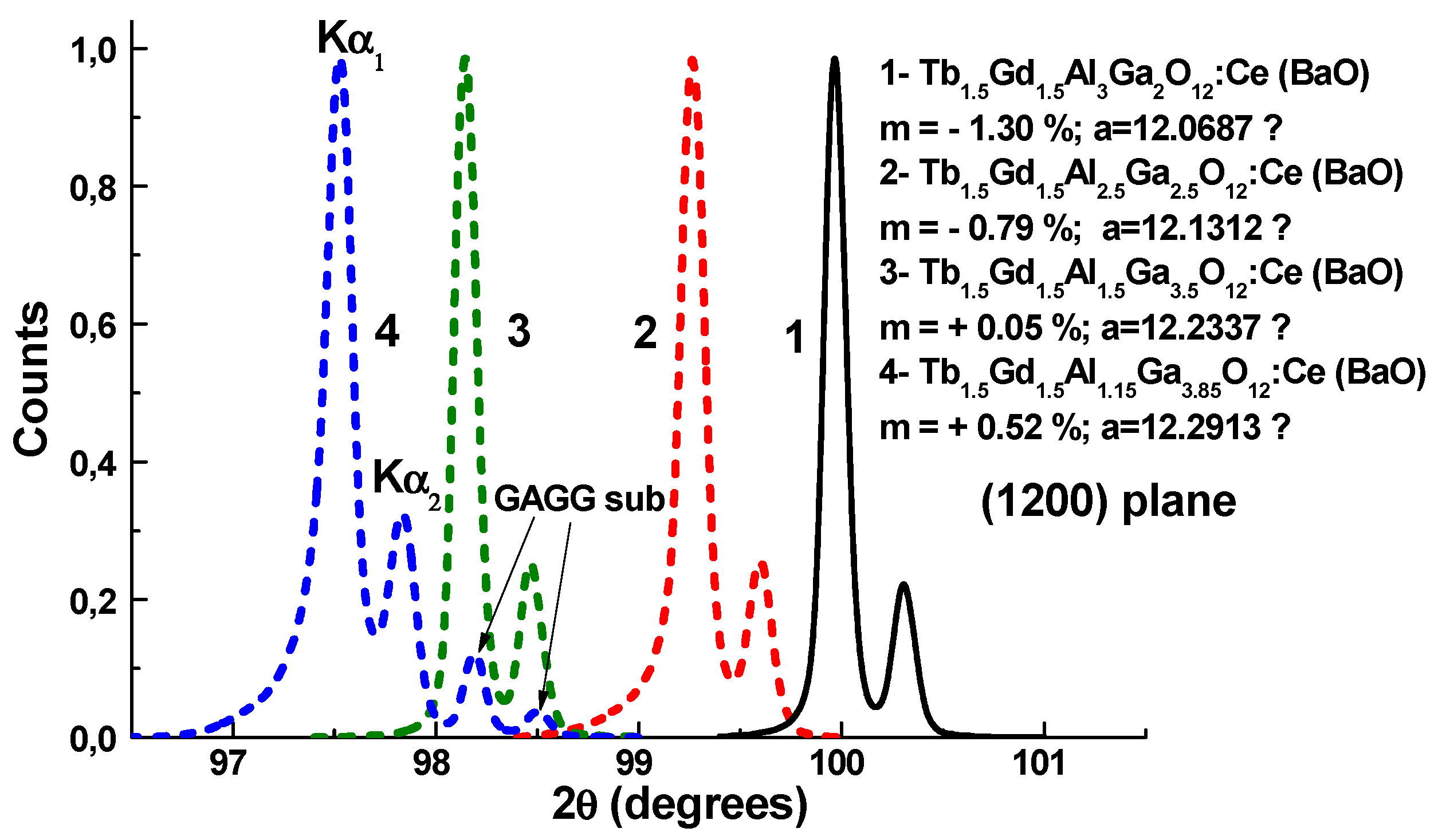
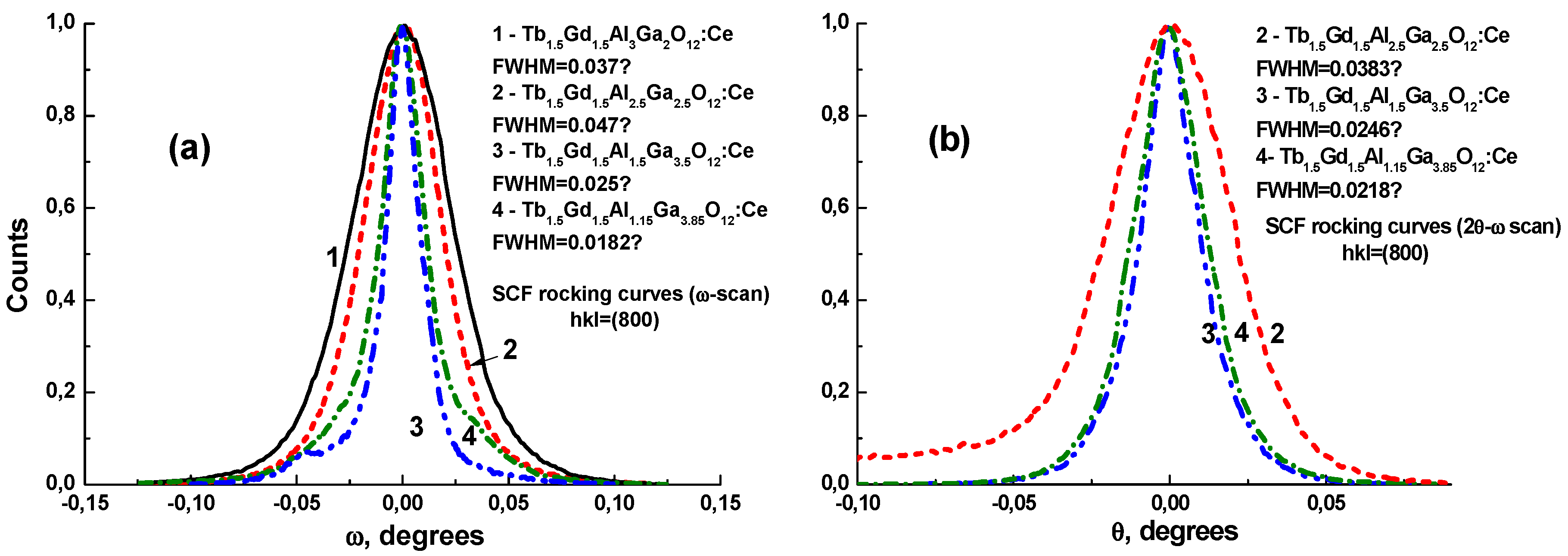
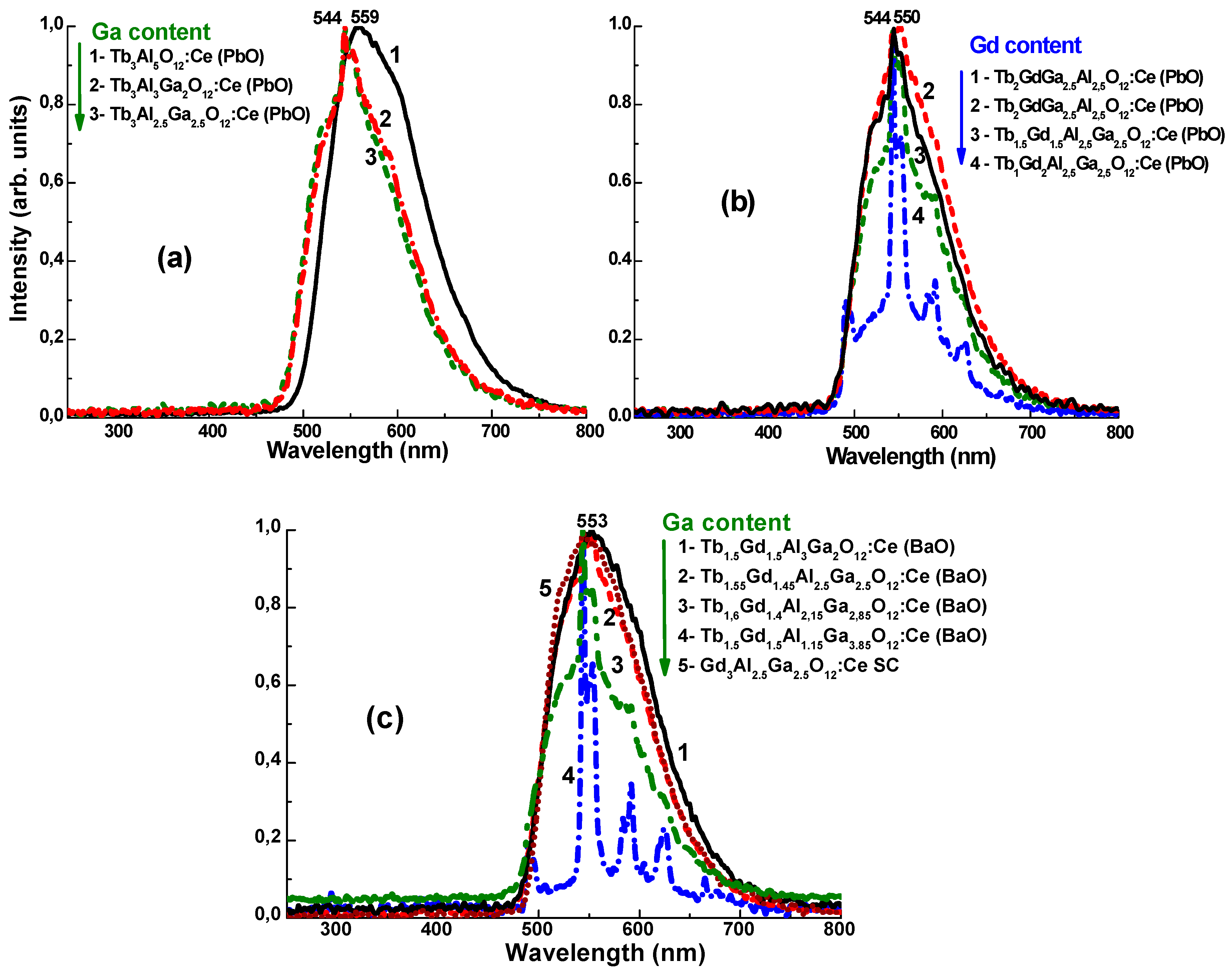
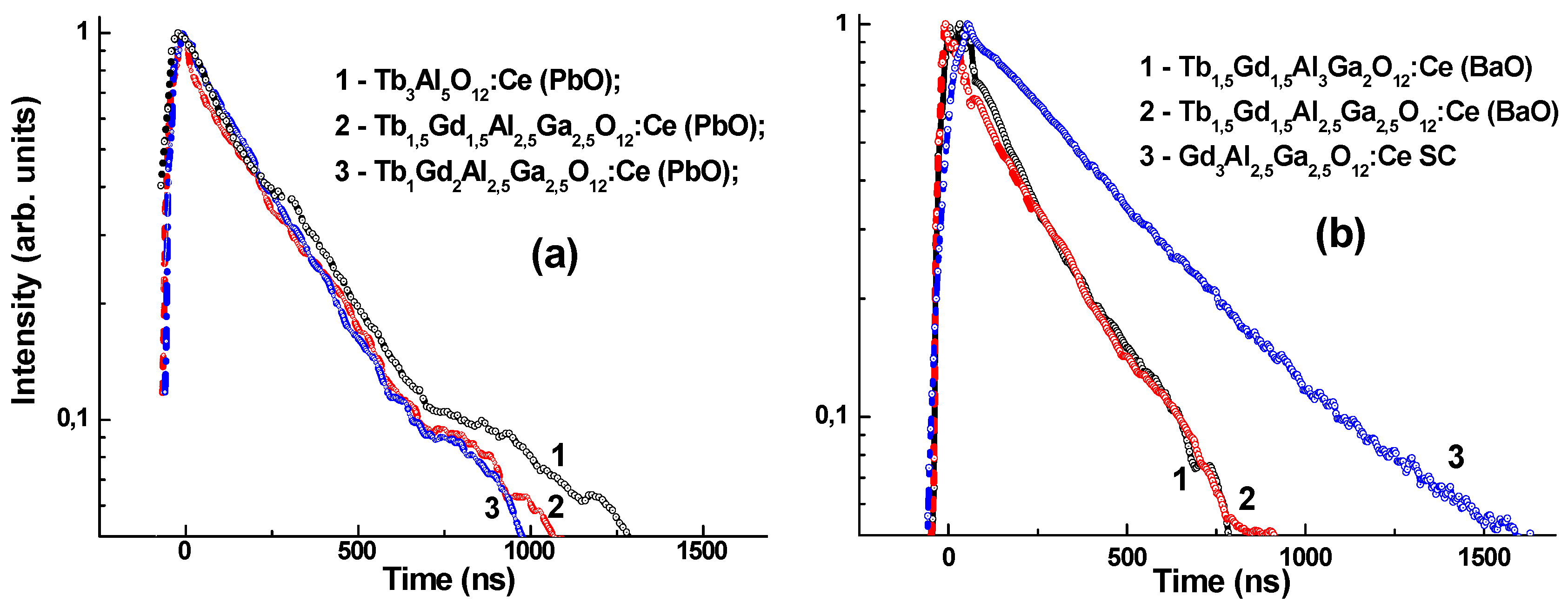
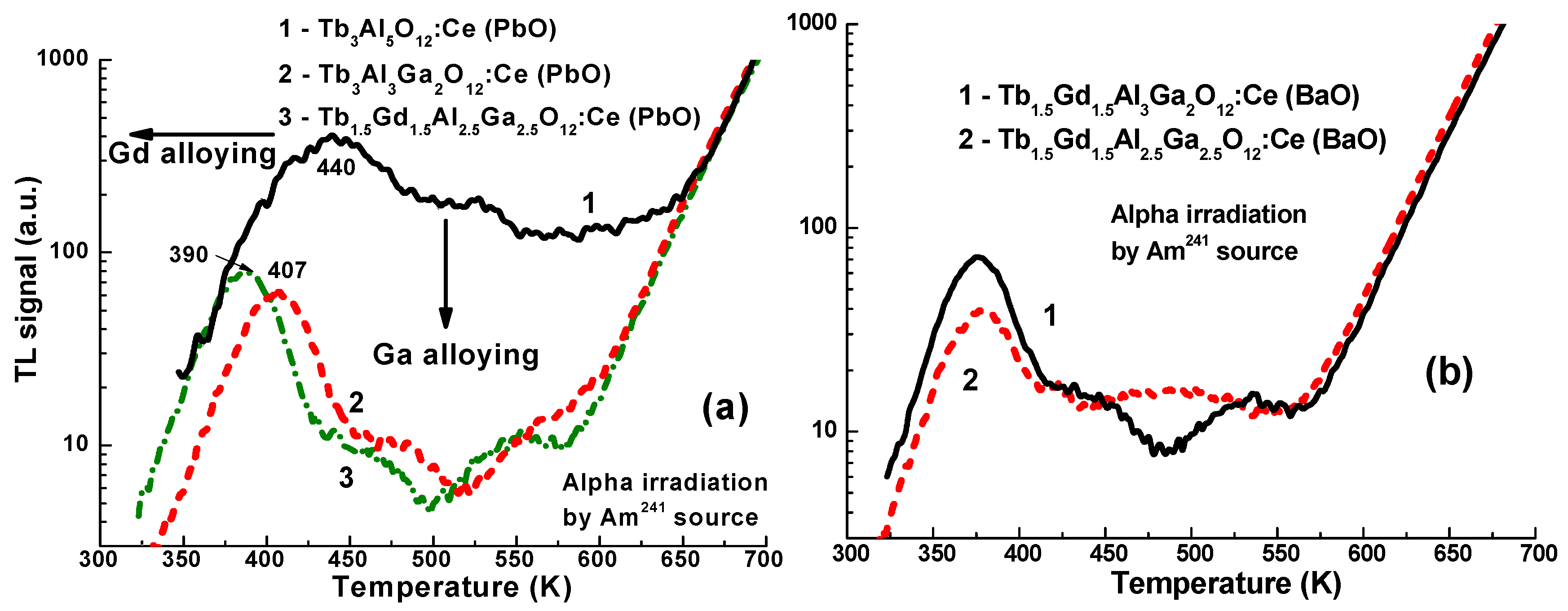

| Content of SCF Samples | Flux | Substrate | m, % | λmax, nm | t1/e/t1/20, ns | LY, % | Reference |
|---|---|---|---|---|---|---|---|
| YAG:Ce | PbO | YAG | - | 535 | 67.3 | 100 | [21,31] |
| LuAG:Ce | PbO | YAG | −0.82 | 509 | 52.8 | 205 | [21,31] |
| Tb1.5Gd1.5Al3Ga2O12:Ce | BaO | GAGG | −1.30 | 553 | 228/728 | 380 | |
| Tb1.5Gd1.5Al2.5Ga2.5O12:Ce | BaO | GAGG | −0.79 | 543 | 201/893 | 270 | |
| Tb1.5Gd1.5Al1.5Ga3.5O12:Ce | BaO | GAGG | +0.05 | 543 | 183/728 | 160 | |
| Tb1.5Gd1.5Al1.15Ga3.85O12:Ce | BaO | GAGG | +0.5 | 543 | 103/868 | 50 | |
| Tb3Al5O12:Ce | PbO | GAGG | −1.29 | 560 | 306/1795 | 195 | [21] |
| Tb3Al3Ga2O12:Ce | PbO | GAGG | −0.49 | 543 | 435/1340 | 200 | [36] |
| Tb3Al2.5Ga2.5O12:Ce | PbO | GAGG | −0.37 | 543 | 456/1368 | 235 | [36] |
| Tb2GdAl2.5Ga2.5O12:Ce | PbO | GAGG | −0.20 | 543 | 291/883 | 254 | [36] |
| Tb1.5Gd1.5Al2.5Ga2.5O12:Ce | PbO | GAGG | −0.12 | 543 | 333/990 | 380 | [36] |
| TbGd2Al2.5Ga2.5O12:Ce | PbO | GAGG | −0.04 | 543 | 299/88 | 160 | [36] |
| Gd3Al2.5Ga2.5O12:Ce SC | - | - | - | 547 | 441/1536 | 381 | [21,31] |
| Gd3Al2Ga3O12:Ce SC | - | - | - | 549 | 240/876 | 365 | [21,31] |
| Garnet Content | Type of Flux | Segregation Coefficient | ||
|---|---|---|---|---|
| Gd3+ | Ga3+ | Ce3+ | ||
| Tb3Al5–2.9Ga0–2.1O12:Ce | PbO | 0.59–0.65 | 0.004–0.005 | |
| Tb2–0.9Gd1–2.1Al2.25–2.4Ga2.75–2.6O12:Ce | PbO | 1.0–1.1 | 0.735–0.82 | 0.0095–0.02 |
| Tb1.5Gd1.5Al3–1.15Ga2–3.85O12:Ce | BaO | 1.0–1.05 | 1.0–1.1 | 0.012–0.14 |
© 2017 by the authors. Licensee MDPI, Basel, Switzerland. This article is an open access article distributed under the terms and conditions of the Creative Commons Attribution (CC BY) license (http://creativecommons.org/licenses/by/4.0/).
Share and Cite
Gorbenko, V.; Zorenko, T.; Witkiewicz, S.; Paprocki, K.; Sidletskiy, O.; Fedorov, A.; Bilski, P.; Twardak, A.; Zorenko, Y. LPE Growth of Single Crystalline Film Scintillators Based on Ce3+ Doped Tb3−xGdxAl5−yGayO12 Mixed Garnets. Crystals 2017, 7, 262. https://doi.org/10.3390/cryst7090262
Gorbenko V, Zorenko T, Witkiewicz S, Paprocki K, Sidletskiy O, Fedorov A, Bilski P, Twardak A, Zorenko Y. LPE Growth of Single Crystalline Film Scintillators Based on Ce3+ Doped Tb3−xGdxAl5−yGayO12 Mixed Garnets. Crystals. 2017; 7(9):262. https://doi.org/10.3390/cryst7090262
Chicago/Turabian StyleGorbenko, Vitalii, Tetiana Zorenko, Sandra Witkiewicz, Kazimierz Paprocki, Oleg Sidletskiy, Alexander Fedorov, Paweł Bilski, Anna Twardak, and Yuriy Zorenko. 2017. "LPE Growth of Single Crystalline Film Scintillators Based on Ce3+ Doped Tb3−xGdxAl5−yGayO12 Mixed Garnets" Crystals 7, no. 9: 262. https://doi.org/10.3390/cryst7090262







